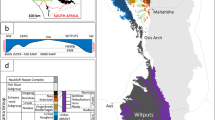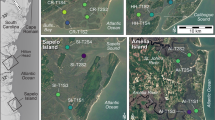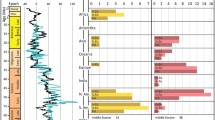Abstract
Bioturbation, the physical and chemical mixing of sediment by burrowing animals, exerts an important control on the character of modern marine sediments and biogeochemical cycling1,2,3,4,5,6,7,8,9. Here we show that the mixing of sediments on marine shelves remained limited until at least the late Silurian, 120 million years after the Precambrian–Cambrian transition. We present ichnological, stratigraphic and taphonomic data from a range of lower Phanerozoic siliciclastic successions spanning four palaeocontinents. The protracted development of the sediment mixed layer is also consistent with sulphur data and global sulphur model simulations. The slow increase in the intensity of bioturbation in the sediment record suggests that evolutionary advances in sediment colonization outpaced advances in sediment mixing. We conclude that ecosystem restructuring caused by the onset of significant infaunal mobile deposit feeding (‘bulldozing’) occurred well after both the Cambrian Explosion and the Great Ordovician Biodiversification Event.
This is a preview of subscription content, access via your institution
Access options
Subscribe to this journal
Receive 12 print issues and online access
$259.00 per year
only $21.58 per issue
Buy this article
- Purchase on Springer Link
- Instant access to full article PDF
Prices may be subject to local taxes which are calculated during checkout




Similar content being viewed by others
References
Aller, R. C. Bioturbation and remineralization of sedimentary organic-matter—effects of redox oscillation. Chem. Geol. 114, 331–345 (1994).
Aller, R. C. in Animal-Sediment Relations: The Biogenic Alteration of Sediments (eds McCall, P. L. & Tevesz, M. J. S.) 53–102 (Plenum Press, 1982).
Aller, R. C., Yingst, J. Y. & Ullman, W. J. Comparative biogeochemistry of water in intertidal Onuphis (Polychaeta) and Upogebia (Crustacea) burrows; temporal patterns and causes. J. Mar. Res. 41, 571–604 (1983).
Rhoads, D. C. & Young, D. K. Influence of deposit-feeding organisms on sediment stability and community trophic structure. J. Mar. Res. 28, 150–178 (1970).
Thayer, C. W. Biological bulldozers and the evolution of marine benthic communities. Science 203, 458–461 (1979).
Thayer, C. W. in Biotic Interactions in Recent and Fossil Benthic Communities (eds Tevesz, M. J. S. & McCall, P. L.) 480–595 (Plenum Press, 1983).
Boudreau, B. P. Mean mixed depth of sediments: The wherefore and the why. Limnol. Oceanogr. 43, 524–526 (1998).
Teal, L. R., Bulling, M. T., Parker, E. R. & Solan, M. Global patterns of bioturbation intensity and mixed depth of marine soft sediments. Aquat. Biol. 2, 207–218 (2008).
Teal, L. R., Parker, E. R. & Solan, M. Sediment mixed layer as a proxy for benthic ecosystem process and function. Mar. Ecol. Prog. Ser. 414, 27–40 (2010).
Bromley, R. G. & Ekdale, A. A. Composite ichnofabrics and tiering of burrows. Geol. Mag. 123, 59–65 (1986).
Tarhan, L. G. & Droser, M. L. Widespread delayed mixing in early to middle Cambrian marine shelfal settings. Palaeogeogr. Palaeoclimatol. Palaeoecol. 399, 310–322 (2014).
Mangano, M. G. & Buatois, L. A. Decoupling of body-plan diversification and ecological structuring during the Ediacaran–Cambrian transition: Evolutionary and geobiological feedbacks. Proc. R. Soc. B 281, 20140038 (2014).
Bluth, G. J. S. & Kump, L. R. Phanerozoic paleogeology. Am. J. Sci. 291, 284–308 (1991).
Middleburg, J. J., Soetaert, K. & Herman, P. M. J. Empirical relationships for use in global diagenetic models. Deep-Sea Res. I 44, 327–344 (1997).
Miller, M. F. & Smail, S. E.. A semiquantitative field method for evaluating bioturbation on bedding planes. Palaios 12, 391–396 (1997).
Droser, M. L. & Bottjer, D. J. A semiquantitative field classification of ichnofabric. J. Sediment. Petrol. 56, 558–559 (1986).
Tarhan, L. G., Droser, M. L. & Hughes, N. C. Exceptional trace fossil preservation and mixed layer development in Cambro-Ordovician siliciclastic strata. Mem. Assoc. Australas. Palaeontol. 45, 71–88 (2014).
Canfield, D. E. & Farquhar, J. Animal evolution, bioturbation, and the sulfate concentration of the oceans. Proc. Natl Acad. Sci. USA 106, 8123–8127 (2009).
Wu, N. P., Farquhar, J., Strauss, H., Kim, S. T. & Canfield, D. E. Evaluating the S-isotope fractionation associated with Phanerozoic pyrite burial. Geochim. Cosmochim. Acta 74, 2053–2071 (2010).
Leavitt, W. D., Halevy, I., Bradley, A. S. & Johnston, D. T. Influence of sulfate reduction rates on the Phanerozoic sulfur isotope record. Proc. Natl Acad. Sci. USA 110, 11244–11249 (2013).
Horita, J., Zimmermann, H. & Holland, H. D. Chemical evolution of seawater during the Phanerozoic: Implications from the record of marine evaporites. Geochim. Cosmochim. Acta 66, 3733–3756 (2002).
Brennan, S. T., Lowenstein, T. K. & Horita, J. Seawater chemistry and the advent of biocalcification. Geology 32, 473–476 (2004).
Gill, B. C., Lyons, T. W. & Saltzman, M. R. Parallel, high-resolution carbon and sulfur isotope records of the evolving Paleozoic marine sulfur reservoir. Palaeogeogr. Palaeoclimatol. Palaeoecol. 256, 156–173 (2007).
Berner, R. A. Phanerozoic atmospheric oxygen: New results using the GEOCARBSULF model. Am. J. Sci. 309, 603–606 (2009).
Laflamme, M., Darroch, S. A. F., Tweedt, S. M., Peterson, K. J. & Erwin, D. H. The end of the Ediacara biota: Extinction, biotic replacement, or Cheshire Cat? Gondwana Res. 23, 558–573 (2013).
Awramik, S. M. Precambrian columnar stromatolite diversity—reflection of metazoan appearance. Science 174, 825–827 (1971).
Meysman, F. J. R., Middelburg, J. J. & Heip, C. H. R. Bioturbation: A fresh look at Darwin’s last idea. Trends Ecol. Evol. 21, 688–695 (2006).
Seilacher, A. Trilobite palaeobiology and substrate relationships. Trans. R. Soc. Edinburgh 76, 231–237 (1985).
Seilacher, A. Trace Fossil Analysis (Springer, 2007).
Crimes, T. P. Production and preservation of trilobite resting and furrowing traces. Lethaia 8, 35–48 (1975).
Berner, R. A. Early Diagenesis: A Theoretical Approach (ed. Holland, H. D.) (Princeton Series in Geochemistry, Princeton Univ. Press, 1980).
Ekdale, A. A. & De Gibert, J. M. Paleoethologic significance of bioglyphs: Fingerprints of the subterraneans. Palaios 25, 540–545 (2010).
Droser, M. L., Jensen, S., Gehling, J. G., Myrow, P. M. & Narbonne, G. M. Lowermost Cambrian ichnofabrics from the Chapel Island Formation, Newfoundland: Implications for Cambrian substrates. Palaios 17, 3–15 (2002).
Jensen, S., Saylor, B. Z., Gehling, J. G. & Germs, G. J. B. Complex trace fossils from the terminal Proterozoic of Namibia. Geology 28, 143–146 (2000).
Vannier, J., Calandra, I., Gaillard, C. & Zylinska, A. Priapulid worms: Pioneer horizontal burrowers at the Precambrian–Cambrian boundary. Geology 38, 711–714 (2010).
Wetzel, A. & Aigner, T. Stratigraphic completeness: Tiered trace fossils provide a measuring stick. Geology 14, 234–237 (1986).
Elliott, R. E. A classification of subaqueous sedimentary structures based on rheological and kinematical parameters. Sedimentology 5, 193–209 (1965).
Halevy, I., Peters, S. E. & Fischer, W. W. Sulfate burial constraints on the Phanerozoic sulfur cycle. Science 337, 331–334 (2012).
Canfield, D. E. Sulfur isotopes in coal constrain the evolution of the Phanerozoic sulfur cycle. Proc. Natl Acad. Sci. USA 110, 8443–8446 (2013).
Acknowledgements
This research was supported by an NSF Graduate Research Fellowship, Amherst College John Mason Clarke Fellowship, Janet M. Boyce Memorial Fellowship and grants from the Society for Sedimentary Geology, Geological Society of America, Paleontological Society, American Museum of Natural History, Sigma Xi, InfoQuest Foundation, Evolving Earth Foundation and the Community Foundation (L.G.T.), as well as the NSF Earth-Life Transitions Program and NASA NAI UCR node (N.J.P.) and NASA NAI MIT node (D.J.T.). Permitted access to sections was provided by the Fortune Head Ecological Reserve (Canada) and Death Valley National Park (USA). Fieldwork was facilitated by D. Auerbach, E. Conrado, R. Dahl, J. Esteve, T. Garlock, J. Gehling, E. Haddad, C. Hall, L. Hancock, S. Jensen, L. Joel, T. Johnston, K. Keenan, N. McKenzie, A. Miller, P. Myrow, A. Ruiz, A. Sappenfield and R. Thomas. This paper benefited from discussion with D. Hardisty and C. Reinhard.
Author information
Authors and Affiliations
Contributions
L.G.T. conceived the study, with input from all authors. L.G.T. collected all field data and performed analyses. L.G.T. and N.J.P. developed the bioturbation-dependent sulphate model, with input from D.T.J. L.G.T. wrote the manuscript with input from all authors.
Corresponding author
Ethics declarations
Competing interests
The authors declare no competing financial interests.
Supplementary information
Supplementary Information
Supplementary Information (PDF 9512 kb)
Rights and permissions
About this article
Cite this article
Tarhan, L., Droser, M., Planavsky, N. et al. Protracted development of bioturbation through the early Palaeozoic Era. Nature Geosci 8, 865–869 (2015). https://doi.org/10.1038/ngeo2537
Received:
Accepted:
Published:
Issue Date:
DOI: https://doi.org/10.1038/ngeo2537
This article is cited by
-
Late Paleozoic oxygenation of marine environments supported by dolomite U-Pb dating
Nature Communications (2024)
-
Microfossil Assemblages and Indication of the Source and Preservation Pattern of Organic Matter from the Early Cambrian in South China
Journal of Earth Science (2022)
-
Exceptional sulfur and iron isotope enrichment in millimetre-sized, early Palaeozoic animal burrows
Scientific Reports (2020)
-
Early Cambrian origin of the shelf sediment mixed layer
Nature Communications (2018)
-
Biological rejuvenation of iron oxides in bioturbated marine sediments
The ISME Journal (2018)



